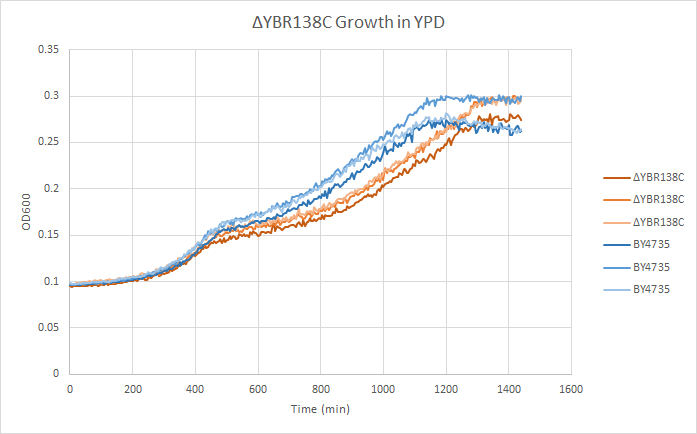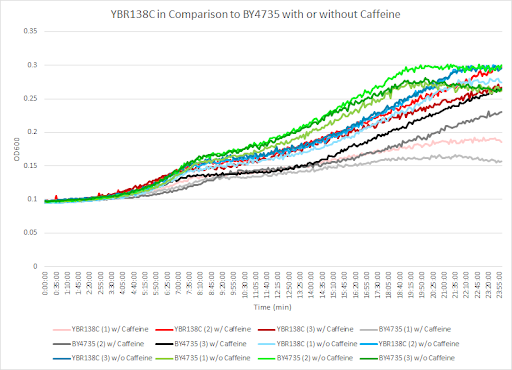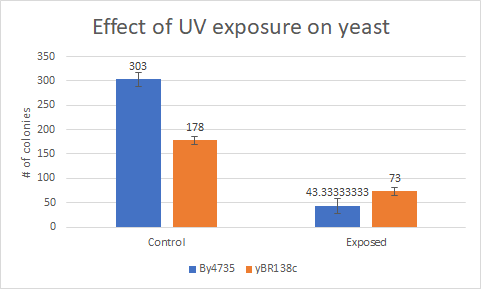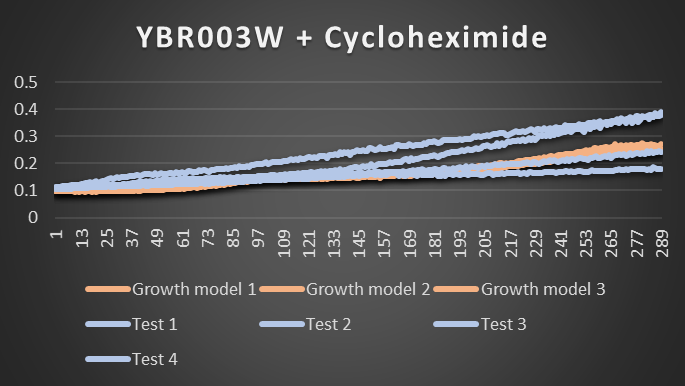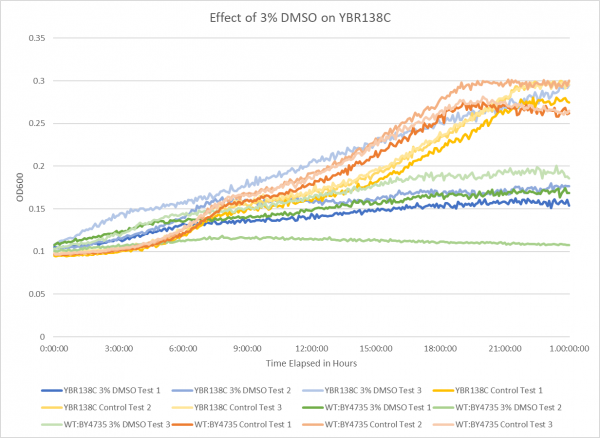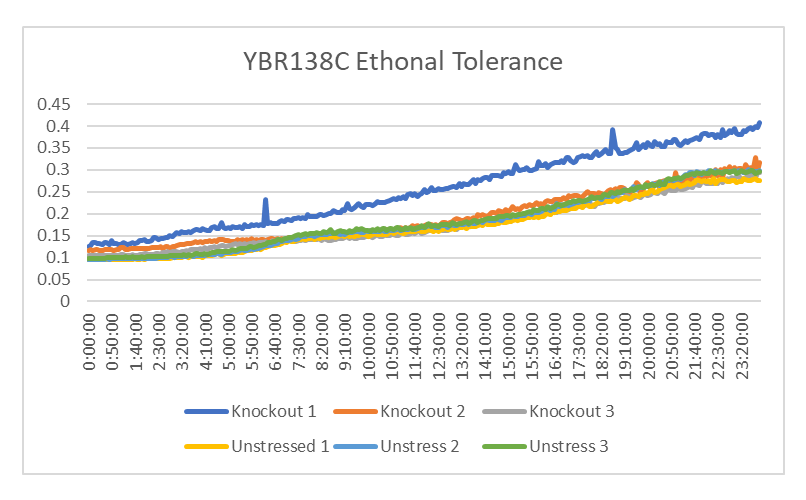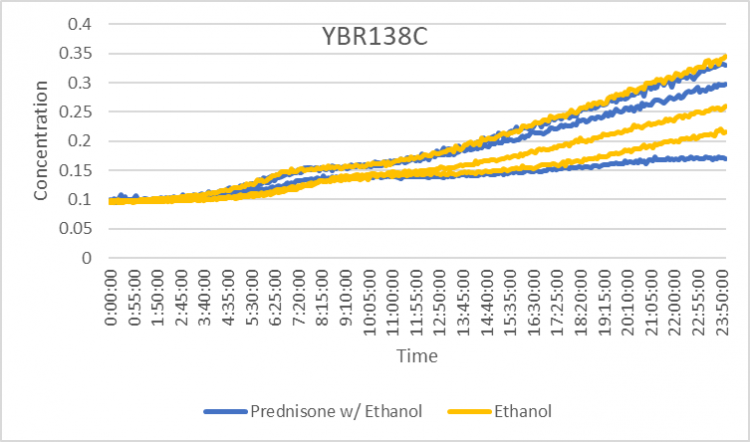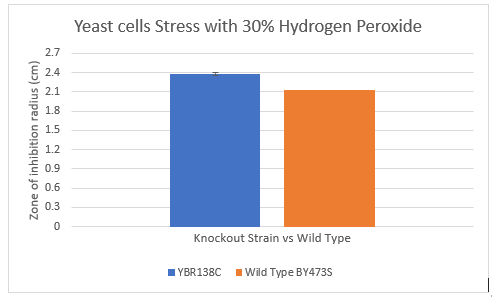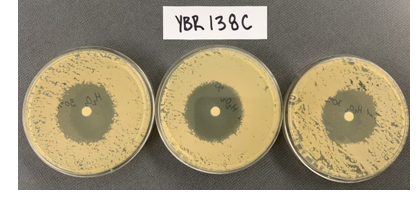Difference between revisions of "YBR138C"
(→Zone of Inhibition of 30% Hydrogen Peroxide on YKR005C) |
|||
| Line 101: | Line 101: | ||
===Zone of Inhibition of 30% [https://wiki.yeastgenome.org/index.php/UW-Stout/Hydrogen_peroxide_FA19 Hydrogen Peroxide] on YKR005C=== | ===Zone of Inhibition of 30% [https://wiki.yeastgenome.org/index.php/UW-Stout/Hydrogen_peroxide_FA19 Hydrogen Peroxide] on YKR005C=== | ||
| − | + | [[File:JJ6.PNG]] | |
| − | + | [[File:JaredJ6.PNG]] | |
<protect> | <protect> | ||
Revision as of 13:35, 17 December 2019
Share your knowledge...Edit this entry! <protect>
| Systematic name | YBR138C |
| Gene name | |
| Aliases | HDR1 |
| Feature type | ORF, Uncharacterized |
| Coordinates | Chr II:515336..513762 |
| Primary SGDID | S000000342 |
Description of YBR138C: Cytoplasmic protein of unknown function, potentially phosphorylated by Cdc28p; YBR138C is not an essential gene[1][2][3]
</protect>
Community Commentary
About Community Commentary. Please share your knowledge!
Protein Details
Protein Modification
Modification(s): Phosphorylation
Identified as an efficient substrate of Clb2-Cdk1-as1 in a screen of a proteomic GST-fusion library. [3] [4]
This gene is part of the UW-Stout Orphan Gene Project. Learn more here.
Growth Curve
In a BY4735 background, knocking out YBR138C seems to have no effect on growth rate in log-phase. In this assay, the BY4735 strain's doubling time was 414 minutes, while the YBR138C knock-out strain's doubling time was 432minutes. (These doubling times are the means of three experiments.)
Caffeine and Yeast Cells
This graph shows the growth curve with and without caffeine. It has the knockout strain and wild type yeast cells. The caffeine enhanced the growth in both wild type and knockout strain. The average doubling time between the three experiments for the knockout strand was 689.46 minutes. The caffeine also had a positive effect on the growth curve for the wild type with the average doubling time being 1245.02 minutes. The results were concluded from the wild type and knockout strand was with this amount of caffeine it leads to an increase in growth.
The protocol can be found at
Caffeine
This bar graph shows that compared to a BY4735 background, yBR138c makes yeast less sensitive to UV light exposure.
The protocol can be found at
UV Light Exposure
Cycloheximide effecting YBR138C
In this image we see that tests 2&3 are surviving and tests 1&4 are not doing as well under this stress. 1 is very low compared to 3 and this is kind of weird. The three Growth models are YBR138C not be stressed.
Effect of 3% DMSO on YBR138C
The graph above shows the effect of 3% DMSO on YBR138C. From the data represented the average doubling rate for the YBR138C knockout strain without DMSO was 570 minutes. When DMSO is added the average doubling time increased to 835 minutes. This shows that 3% DMSO did add stress to this knockout strain. The average doubling time of WT:BY4735 without DMSO was 514 minutes. The average doubling rate for WT:BY4735 with DMSO was 1529 minutes. If we compare the average doubling rate of WT:BY4735 with DMSO to YBR138C with DMSO we can see that without the YBR138C gene the yeast was able to grow more quickly under DMSO induced stress, so much so that it almost halves the doubling time. Given both controls it also appears that the YBR138C gene has very little effect on the growth of the yeast in optimal conditions.
Ethanol Tolerance in YBR138C
This graph shows the growth between YBR138C treated and untreated with ethanol. The rate of growth of the treated yeast is 1324.94 minutes. The rate of growth of the untreated yeast is 166.2485 minutes. This shows that the strands of YBR138C treated with ethanol had a decrease rate of growth compared to the strands that weren't.
Prednisone Effects on YBR138C
The graph above shows how dilutions P2 (30 µg/ml) and E2 (10% ethanol solution) impacted the growth rate of the knockout yeast strain YBR138C over 24 hours. The concentration did not double for test 3 of P2 for this experiment, so by taking only the first two test results, the doubling rate averages to around 962.5 minutes for only ethanol. As for the Prednisone with ethanol, the doubling rate averages to around 880 minutes. Overall, the Prednisone increased the rate of growth by about 82.5 minutes. The ethanol typically inhibits the growth of YBR138C more than the Prednisone with ethanol. These results conclude that Prednisone promotes the growth of yeast cells without the gene YBR138C.
1% Formamide Yeast Torture[[1]]
This graph shows the growth curve of the knockout yeast strain YBR138C and wild type BY4735 in 1% formamide in 3 trials. The average calculated doubling time for YBR138C with 1% formamide was 2,710.55 minutes, while the unstressed strain was 3,131.33 minutes. This concluded that the unstressed strain is slightly sensitive to 1% formamide, and grows at a slower pace in this environment. Our stressed wild types doubling time was 3,459.91 minutes, and the unstressed was 2,468.04 minutes. This shows that the addition of 1% formamide constrains growth for the stressed wild type.
Zone of Inhibition of 30% Hydrogen Peroxide on YKR005C
References
See Help:References on how to add references
- ↑ Huh WK, et al. (2003) Global analysis of protein localization in budding yeast. Nature 425(6959):686-91 SGD PMID 14562095
- ↑ Kucharczyk R, et al. (1999) Disruption of six novel yeast genes located on chromosome II reveals one gene essential for vegetative growth and two required for sporulation and conferring hypersensitivity to various chemicals. Yeast 15(10B):987-1000 SGD PMID 10407278
- ↑ 3.0 3.1 Ubersax JA, et al. (2003) Targets of the cyclin-dependent kinase Cdk1. Nature 425(6960):859-64
SGD PMID 14574415 Cite error: Invalid
<ref>tag; name "S000074306" defined multiple times with different content - ↑ submitted by Jeff Ubersax on 2004-01-21
See Help:Categories on how to add the wiki page for this gene to a Category </protect>
